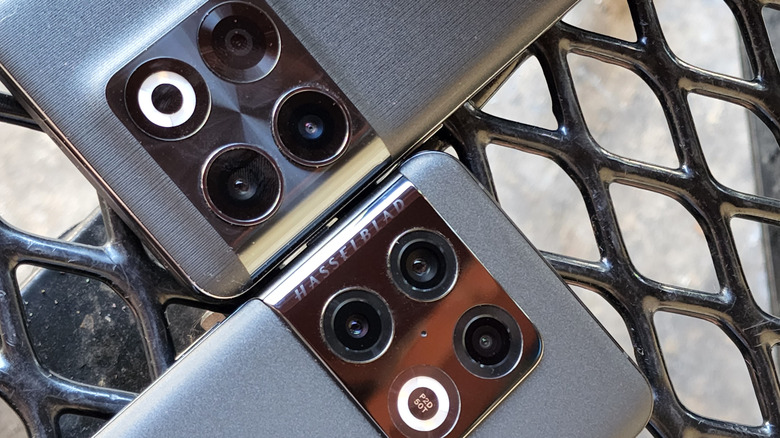OnePlus 10 Pro Vs. OnePlus 10T Camera Review: Is Hasselblad Worth The Premium?
We may receive a commission on purchases made from links.
Last year, OnePlus announced that it was finally going to take cameras seriously by partnering up with Hasselblad. The camera company would lend its expertise to OnePlus's cameras in a three-year partnership starting with the OnePlus 9 series. Sure enough, the phone company's OnePlus flagships bore the Hasselblad logo, along with some camera tuning promising photo realistic coloring in its cameras.
Not coincidentally, the OnePlus 9 Pro was the first OnePlus smartphone that produced consistently good photographic results. This year's OnePlus 10 Pro is similarly capable of producing excellent photos. But now we have the OnePlus 10T, the company's flagship phone for the more budget conscious.
OnePlus managed to bring some great specifications including the Snapdragon 8+ Series 1 processor, oodles of RAM, and a smooth 120 Hz display. But in order to achieve that $649 price tag — which is $150 less than the OnePlus 10 Pro — some sacrifices had to be made. Notably, the OnePlus 10T does not bear the Hasselblad name.
So, I was curious to see what that actually meant: what can OnePlus do with a camera when Hasselblad isn't looking over its shoulder? I spent a day at a theme park (and an evening at my usual night-time photographic haunt), carrying the OnePlus 10 Pro and the OnePlus 10T. Here's what I found out.
The hardware
Before we get too far ahead of ourselves, let's talk about the camera hardware. Right off the bat, it's clear that the Hasselblad name is not the only thing missing from these phones. Starting with the main camera, the OnePlus 10 Pro sports a 48-megapixel sensor with an f/1.8 aperture while the OnePlus 10T carries a 50-megapixel sensor with the same aperture. Once you move past the main sensor, things get much more divergent.
The ultrawide camera is the biggest difference. While the new OnePlus 10T has an adequate 8-megapixel sensor, the OnePlus 10 Pro carries a 50-megapixel ultrawide camera as well. Additionally, the OnePlus 10 Pro's ultrawide sensor is capable of capture 150-degree shots which can make for some cool effects. Plus, the bump up in resolution allows the camera to capture far more detail than the sensor found on the 10T.
Finally, the OnePlus 10 Pro has an 8-megapixel 3.3x optical zoom telephoto lens for its third camera, while the OnePlus 10T carries a paltry 2-megapixel macro sensor. The OnePlus 10T instead relies on a digital crop for zoom shots.
Flexing the main camera
Right off the bat, you can see a big difference between the main cameras on the OnePlus 10 Pro and the OnePlus 10T. Specifically, photos on the OnePlus 10 Pro pop a bit more. They're colored to reflect what things probably "should" look like. The sky and the water are both bright blues. The flags have crisp reds and the blues are star-spangled awesome. In reality, the OnePlus 10T captured a more accurate photo as things actually looked.
On the day these photos were taken, the sky started off quite overcast and cloudy. There was blue in the sky, but the predominant colors were much paler and more diffused (read: white). The carousel in the background is, with all due respect to Great America, not nearly as bright and sharp as the 10 Pro's photo suggests. The reality is things are a bit paler. Of course, the OnePlus 10T did not handle the flapping flags very well, showing an almost double image in the flags along the right-hand side.
Given a choice between these two photos, the OnePlus 10 Pro is the more attractive of the two, but the OnePlus 10T probably more accurately reflects the reality of the shot. Of course, there's no place for reality on social media so I'd probably go with the 10 Pro's shot.
This shot of toys from a game in the park reflects the same attributes. On the OnePlus 10 Pro, colors pop more and are generally more vivid. Reds are redder and pinks are hotter.
Meanwhile, on the OnePlus 10T, the color science overall is bit paler. That's fine when you're looking at the clouds on an overcast day, but the general theme that we're seeing here is that photos on the OnePlus 10T are a bit more washed out across the board. That results in a more photo-realistic shot of an overcast sky, but overall, photos are neither as fun nor as vivid. If you're a purist, that might appeal to you. I like my photos to pop, so I'm sticking to the OnePlus 10 Pro.
Now, the ultrawide camera
As for the ultrawide camera, there is a distinct difference in hardware here. The biggest difference you'll notice between the two cameras comes in the amount of detail that they are capable of capturing. Of course, sensor size has a lot to do with that; a 50-megapixel sensor will capture a lot more detail than an 8-megapixel sensor. That's most noticeable in the well on the right side of the photo. The well is fairly clear on the OnePlus 10 Pro's photo but loses a ton of detail in the OnePlus 10T's capture.
Also, the OnePlus 10T's photo is generally grainier, especially at a 100% crop. This is particularly noticeable on the green and tan buildings on the left side of the photos. Once again, and I don't want to sound like a broken record, but the 10 Pro's photo just pops more. That is the Hasselblad color science at work.
On the OnePlus 10 Pro, the 150-degree ultrawide capability is fun for sure and allows you to capture some really unique shots, like this one from the entrance to the park. It's 100% a novelty, but as with most gimmicks, it's better to have it and not need it. I scoured the park looking for opportunities to use the 150-degree option and this was the best I came up with. More creative individuals or perhaps a different location might yield a cooler result. All the same, I dig it.
Low-light photography
When the lights go down, both phones do a pretty respectable job with the main sensor. Things get dicier when you switch to the ultrawide, so we'll just stick with the main sensor for this comparison. There's one key difference in how the camera sensors handle light sources in particular: on the OnePlus 10 Pro, light sources get a bit more blown out while the OnePlus 10T resorts to a streakier look. Neither is particularly great but, in that aspect alone, I prefer the OnePlus 10 Pro. Light streaks tend to ruin images, and that's definitely the case here.
What's really interesting is that while daylight photos that the OnePlus 10T took tended to be more washed out, that's the opposite case at night. Here's the photo is much warmer than the 10 Pro. The 10T handles the movement of the flags better than the 10Pro as well. Overall, it's a toss-up as to which photo you prefer.
This statue of a soldier with his dog is another matter entirely. I'll show you three photos of this statue, and of the three, the OnePlus 10T above just nailed it the best. Everything in this shot is crisp from the texture of the dog's fur to the flowers on the ground in front of the statute to the fence in the background.
This shot from the OnePlus 10 Pro clearly has some hand shake in it, and this whole photo is just a blurry mess. But I took both of these photos one after another, in the same place, with the same hand. Hand shake is definitely a thing, and phones that aspire to low-light photography need to account for it and the OnePlus 10 Pro did not.
I also took the same photo in night mode (also by hand) and that helped clean up the image a bit on the OnePlus 10 Pro. It's possible there was a psychological element at play here. My brain probably told my hand, "this is night mode so keep still!" I took this photo in night mode on the OnePlus 10T as well, and it was basically indistinguishable from the top photo.
So low light photos are a bit of a mixed bag, which is usually the case with low light photos. In this case, I thought the OnePlus 10T fared particularly well when pitted against the OnePlus 10 Pro, which was a nice surprise.
Selfies
Selfies are another area where the OnePlus 10T compares very favorably to the OnePlus 10 Pro. The OnePlus 10 Pro has a 32-megapixel shooter with a f/2.2 aperture while the OnePlus 10T has a 16-megapixel camera with an f/2.4 sensor. On paper, the OnePlus 10 Pro should be a lot better, but that is not at all the case.
The selfie camera on the 10 Pro is pretty bad. It's important to note that for selfies, on both phones, HDR was set to auto. In the shot above on the left, the sky and the water are both blown out and terribly exposed. It looks like a half-finished painting on white canvas. On the right, the OnePlus 10T keeps a lot of detail in the sky and water. In terms of the texture of my face (which admittedly desperately needed a shave), the larger sensor on the OnePlus 10 Pro did a lot of good there, but the overall shot was borderline unusable.
Just in case you thought that was a fluke, later in the day, for my obligatory photo of the photos sign, I got the same results. The OnePlus 10 Pro did not handle highlights at all, while the OnePlus 10T did just fine in the same circumstances. So, in the case of selfies, I have to give the nod to the OnePlus 10T.
Wrapping it up
Overall, it's important to note that neither of these phones has a bad camera setup. OnePlus has made great strides in the past few years in the photography department. It still falls a bit short of the best smartphone cameras out there, but the gap has narrowed to the point where you have to be really picky to find flaws. That's a great thing because it gives you another option, especially in the U.S. As for the Hasselblad branding on OnePlus cameras, there's still value there.
Most of the commentary you read in this article referred to colors and pop and that's a lot of what Hasselblad brings to the table. Photos shot by the OnePlus 10 Pro are generally going to be better and more sharable than those shot by the OnePlus 10T. Hardware plays a part of that for sure, but you can see Hasselblad's fingerprints there as well.
Whether or not that's worth an extra $150 to you, of course, is another matter entirely. You'll have to wait for our full review to get a sense of the whole package but, from a camera perspective, the differences are subtle, but noticeable. If you forced me to pay with my own money today, I'd fork over the extra money and pick up the OnePlus 10 Pro.
















